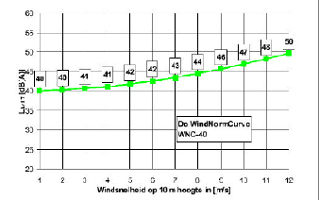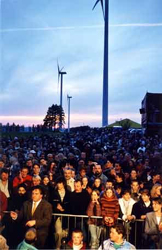 |
 |
 |
 |
 |
 |
 |
 |
 |
 |
 |
 |
Decision making process
Name of the case study
Management of wind-farm developments in Wallonia (landscape and use of land)
Decision making process - stages
The stages involved involved in developing a wind farm are:
• When a developer has a project, possibilities for wind-farm developments are investigated. The EIEolienne, when it is used, could provide the developer with an awareness of specificities of the different regional areas. The "Frameworks for wind-farm developments" tool could be used as guidelines to develop the project.
• The project then progresses to the design stage.
• Developer applies for a license.
The 2 tools : EIEolienne and the Framework would be used (not legally obligatory) to support the decision and argumentation.
• Soon, a Landscape Officer should give expert advice on the project.
Decision making process - levels
The decision making process occurs at the political and technical levels.
Decision making process - sources of information
The 2 main tools, ElEoliennes and the Framework, are expected to be sources of information used during the decision making process. Other research projects, municipality studies, etc. could also be used.
Decision making process - who are the decision makers
All the stakeholders that interact within the project: developers, authorities, residents, etc. are the decison makers.
Decision making process - who made the final decision for project implementation
The final decision to grant the license or not is made by the Regional or Municipal authorities.
Name of tool
EiEolienne planning-map
Decision making process - tools in decision-making process
Authorities use the developed tools to assess the impacts of wind-farm projects (EIA) and support the granting or not of a license to build. To really promote sustainable projects and to help the overall decision-making process, these tools are also expected to provide developers with assistance in the inception of wind-farm projects.
Influences expected as a result of using the tool are the clarification of rules in force for all the stakeholders that interact within the project including developers, authorities, designers, residents, etc :
• Shorten the decision-making process
• Give local authorities a clear basis to deal with the different actors involved (developer, population, energy provider, etc)
• Avoid conflicts with population
• Give the developer references to help the design
The top general objective is to ensure the quality of the landscapes, and the quality of life while developing green energy infrastructures.
The tools gather quantitative benchmarks, usually compared with other countries references.
For instance, a curve from the Netherlands? legislation gives thresholds of noise to be a respected function of the speed of wind. (Framework of Guidelines for wind energy development, p14)

De WindNormCurve WNC-40 from the Dutch legislation specifies the maximal noise of a wind-turbine regarding the wind speed at 10m of height
German references are given to consider the thresholds of stroboscopic effects.
Considering visual impacts, landscape issues as well as public participation, the "Framework" mostly gives qualitative considerations and guidelines. For instance, concerning visual impact, 2 tools are promoted: the photomontage and the definition of zones of visibility of the project (software calculate it regard to the topography). Concerning landscape issues the qualitative recommendations try to promote the enhancement of the main features of the landscapes. The idea is not to camouflage the wind-farms but to use them to structure the landscape. The Framework of guidelines for wind energy development encourages municipalities to involve the population in the project from the beginning".
Name of tool
Framework of Guidelines for Wind Energy development
Decision making process - tools in decision-making process
Authorities use the developed tools to assess the impacts of wind-farm projects (EIA) and support the granting or not of a license to build. To really promote sustainable projects and to help the overall decision-making process, these tools are also expected to provide developers with assistance in the inception of wind-farm projects.
Influences expected as a result of using the tool are the clarification of rules in force for all the stakeholders that interact within the project including developers, authorities, designers, residents, etc :
• Shorten the decision-making process
• Give local authorities a clear basis to deal with the different actors involved (developer, population, energy provider, etc)
• Avoid conflicts with population
• Give the developer references to help the design
The top general objective is to ensure the quality of the landscapes, and the quality of life while developing green energy infrastructures.
The tools gather quantitative benchmarks, usually compared with other countries references.
For instance, a curve from the Netherlands? legislation gives thresholds of noise to be a respected function of the speed of wind. (Framework of Guidelines for wind energy development, p14)

De WindNormCurve WNC-40 from the Dutch legislation specifies the maximal noise of a wind-turbine regarding the wind speed at 10m of height
German references are given to consider the thresholds of stroboscopic effects.
Considering visual impacts, landscape issues as well as public participation, the "Framework" mostly gives qualitative considerations and guidelines. For instance, concerning visual impact, 2 tools are promoted: the photomontage and the definition of zones of visibility of the project (software calculate it regard to the topography). Concerning landscape issues the qualitative recommendations try to promote the enhancement of the main features of the landscapes. The idea is not to camouflage the wind-farms but to use them to structure the landscape. The Framework of guidelines for wind energy development encourages municipalities to involve the population in the project from the beginning".
Decision making process - how was the information for the dmp disseminated
Part of the information on the decision making process is directly disseminated. In Wallonia, a public enquiry is mandatory for every wind-farm project.
Nevertheless, some information is also indirectly disseminated to the public: different expert´ advice is available, and sometimes put on a web site, etc.

Inauguration of the first Wind-farms project in Wallonia, April 2003, Saint-Ode
Decision making process - how was the public involved
In Wallonia, a public enquiry is mandatory for every wind-farm project, after the project is designed and before the license to build is delivered.
Moreover, "The Framework of guidelines for wind energy development " encourages municipalities to involve the population in the project and to develop the notion of public good. References to other countries are made as some wind farm developments involve the owners of grounds located within a certain radius, to avoid frustration by adjacent landowners.
Decision making process - was there public discussion over the project
Public enquiries are mandatory after a project is designed and before the license to build is granted. This stage does not really encourage public involvement within the project. Public participation does depend on local initiatives.
What tools were used to assess sustainability?
Framework of Guidelines for Wind Energy development
More information